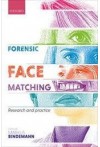- Author(s): Markus Bindemann
- Publisher: Oxford University Press
- Edition: 1 Ed 2021
- ISBN 13 9780198837749
- Approx. Pages 258 + Contents
- Format Paperback
- Approx. Product Size 24 x 16 cms
- Delivery Time 3-5 working days (within Kerala & South India) (Others 7-9 days)
- Shipping Charge Extra (see Shopping Cart)
.....................................................................................................................................
Description
As humans, we are highly tuned to faces. We are very good at finding faces in our visual environment, we enjoy looking at them, and we even find it difficult to ignore them. One reason for this is that we can extract a wealth of social signals by looking at someone's face. Hairstyle, facial hair, and bone structure, for example, can convey a person's gender. Hair colour, skin complexion, and adiposity provide clues to age. Facial expressions can convey a person's emotional state, and the direction a person's eyes are pointing indicates what holds their focus of attention in the immediate envir- onment. Most importantly, however, our faces indicate who we are. They provide the primary visual means by which people can be identified, and for distinguishing one person from another.
In everyday life, we identify faces regularly and seemingly with great ease. Consequently, one might assume this to be a straightforward and highly accurate task. We are certainly very good at recognizing the faces of people that we know, such as those belonging to colleagues, friends, and family. People who are familiar to us in other ways seem to be recognized with great accuracy too, such as the faces of movie stars, famous sports people, and politicians. Contrary to the identification of familiar people, however, we are poor at identifying the faces of unfamiliar people, whom we have never met before, despite the fact that important tasks depend on this. Passport control at airports and borders, for example, depends on the identification of people who are not known to the observer, by comparing their faces to photo-identity docu- ments. And police investigations frequently require the comparison of footage of a target person with the faces of suspects to make an identification. In these applied set- tings, these identification tasks are referred to as facial (image) comparison and are utilized widely on a national and international scale. However, the systematic study and validation of these identification processes by practitioners has not kept pace with their application in the field.
In psychology, a similar identification task is known as 'forensic' or 'unfamiliar face matching, because it requires the comparison of two or more instances of a face to de- cide if these provide an identity match, by depicting the same person, or a mismatch, comprising of similar-looking but different people. In recent years, this task has come to the fore as a field of study in its own right because face matching differs from other ways in which people can be identified. The recognition of familiar faces, for example, has been studied extensively in psychology, and theories of this process have been in existence for more than 30 years. Similarly, face-memory paradigms, in which obser- vers have to recognize newly learned faces after an interval, have been applied exten- sively in the study of eyewitness testimony. Face matching, on the other hand, does not involve prior exposure to a face, to generate familiarity or an eyewitness memory, at all.
......................................................................................................................................
Table of Contents
1. Person Identification at Airports During Passport Control
2. Factors Limiting Face Matching at Passport Control and in Police Investigations
3. Steps Towards a Cognitive Theory of Unfamiliar Face Matching
4. Understanding Professional Expertise in Unfamiliar Face Matching
5. Can Face Identification Ability Be Trained? Evidence for Two Routes to Expertise
6. Individual Differences Between Observers in Face Matching
7. Forensic Face Matching: Procedures and Application
8. Forensic Face Matching: A Legal Perspective Andrew Roberts
9. Automatic Recognition Systems and Human Computer Interaction in Face Matching
10. Realistic Masks in the Real World
......................................................................................................................................
Author Details
Markus Bindemann

